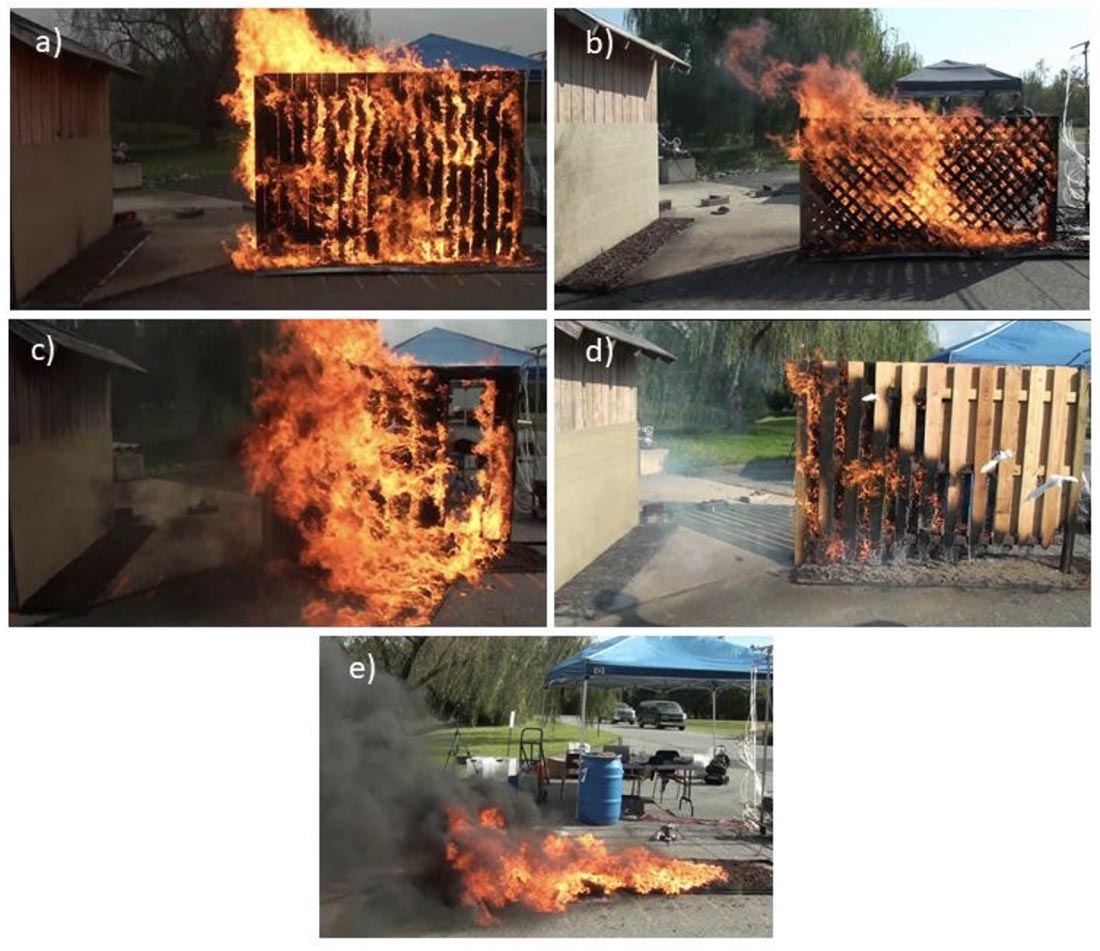
lattice fences, C) wood-plastic composite #1 fence, D) good neighbor fence, E) rubber mulch. (From the NIST research)
Three weeks ago a television station in Dallas, FOX 4, streamed live video as a grass fire spread across a field and reached densely-packed houses, eventually destroying 9 and damaging another 17. There were several reasons why the structures were so vulnerable, including medium-heavy vegetation in the field adjacent to the property lines, very little impact from efforts of the fire department to stop the spread, no air support, and wood fences that connected all of the properties on the rear and sides of the homes.
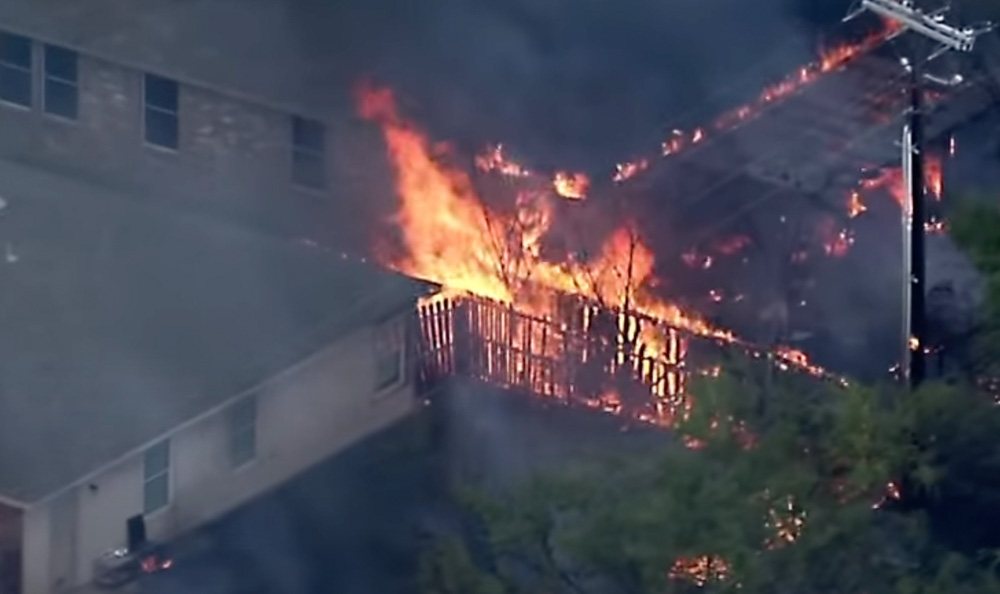
On August 10 the National Institute of Standards and Technology (NIST) published results of 187 experiments that examined how fire spread toward a structure is affected by combustible fences and mulch under conditions that may be encountered in a wildland-urban interface (WUI) fire. They looked at mulch only, fence only, fence plus mulch, parallel fences, and long range firebrands. The materials studied were western red cedar, California redwood, pine, vinyl, and wood-plastic composites. Fence styles included privacy, lattice, and good neighbor (board on board).
A small structure was located between zero and up to six feet downwind of the fence or mulch bed as a target for flames and firebrands. A target mulch bed at the base of the structure tested the ability of firebrands produced by the burning fence and mulch bed to ignite spot fires that threatened the structure.
While not many homeowners place store-bought mulch below their fences, it can be common for debris to build up along the base on one or both sides. The amount and flammability can be extremely variable, but the researchers’ use of mulch gave them control over the flammable material which could be consistently duplicated in their experiments.
The study found that firebrands capable of igniting spot fires downwind were generated by nearly all combinations of fence and mulch tested in this study. All wood fences with mulch at the base caused spot fires in the target mulch bed. Spot fires were often ignited within a few minutes of mulch and fence ignition. Shredded hardwood mulch and pine bark mulch burned and emitted firebrands for longer than an hour. Ignition of spot fires was also demonstrated from firebrands transported by the wind over distances as far as 156 feet from the burning item under high wind conditions and over a paved surface.
The research generated a number of recommendations:
- Avoid parallel fences, to reduce exposure to large flames. Parallel fences can result in highly hazardous fuel accumulation corridors that are difficult to access and maintain. Spacing of 3 feet between fences is not sufficient.
- Avoid proximity to other combustible fuels, to reduce fire intensity and limit fire spread. This includes fuels above the fence and fuels across parcel boundaries. Avoid mulch at base of fence.
- Avoid proximity of combustible fences to residence, including neighboring residence, to prevent direct ignition.
- Fire spread is more likely with wood and wood-plastic composite fences than with fences made of vinyl or noncombustible materials such as stone, brick, or steel.
- Keep fence and yard clear of debris, to reduce the amount of fuel and potential pathways for fire.
- Harden structures against firebrands to prevent structure ignition from embers produced by fences or other combustible sources.
The video from the July 25 fire in Texas does not clearly show the fences between the residences, but it is likely that they directly connected to the structures. An example is seen in the photo below of two homes in Superior, Colorado, one of the communities devastated by the Marshall Fire that destroyed 991 structures south of Boulder December 30, 2021.
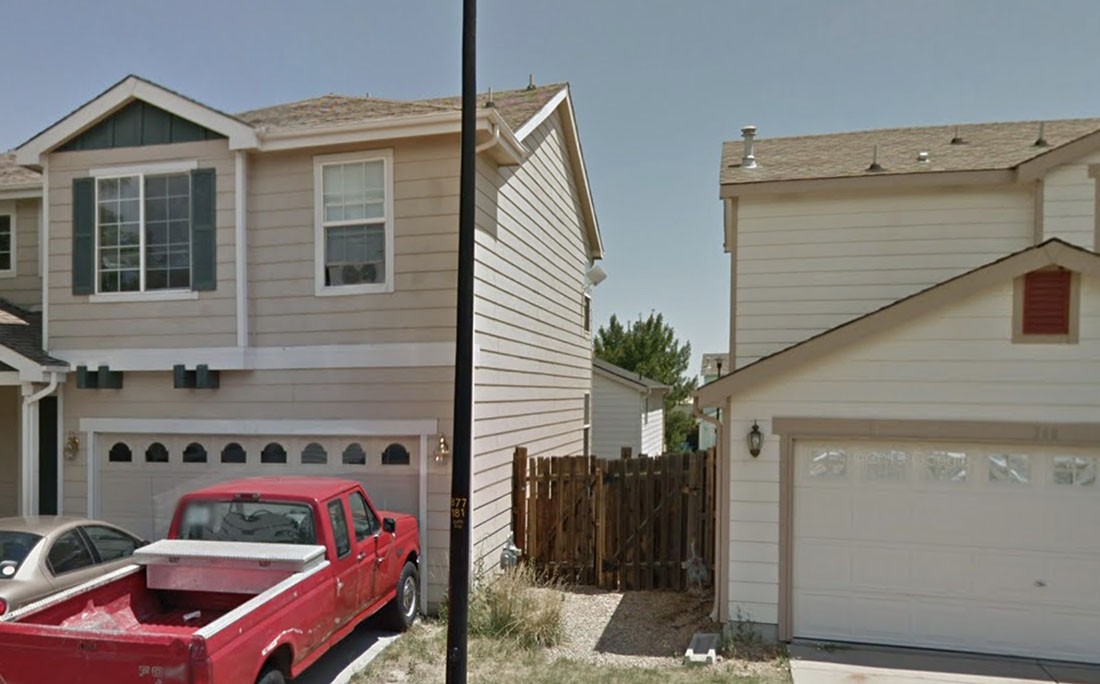
The images below are from the FOX 4 Dallas-Fort Worth video shot July 25, 2022.
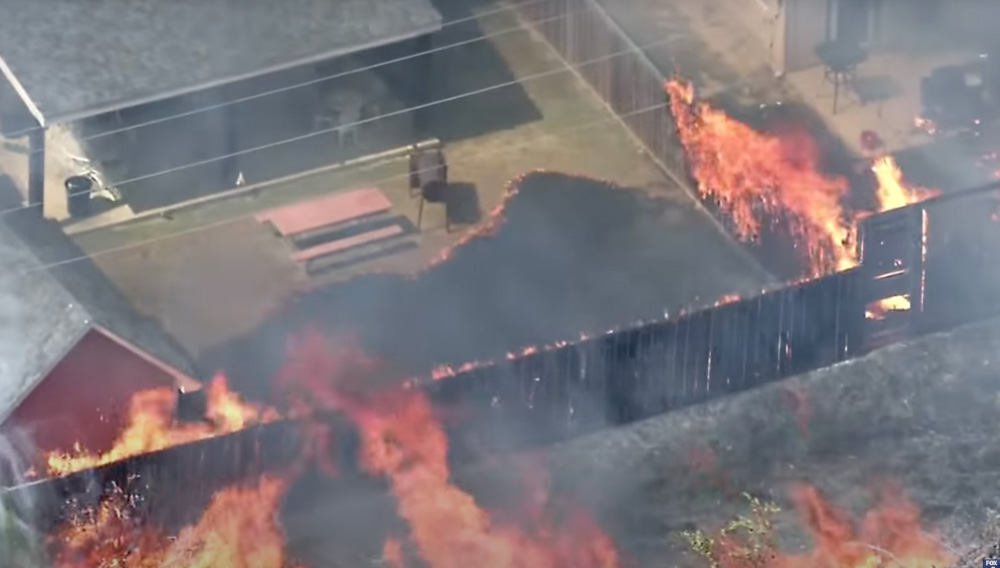
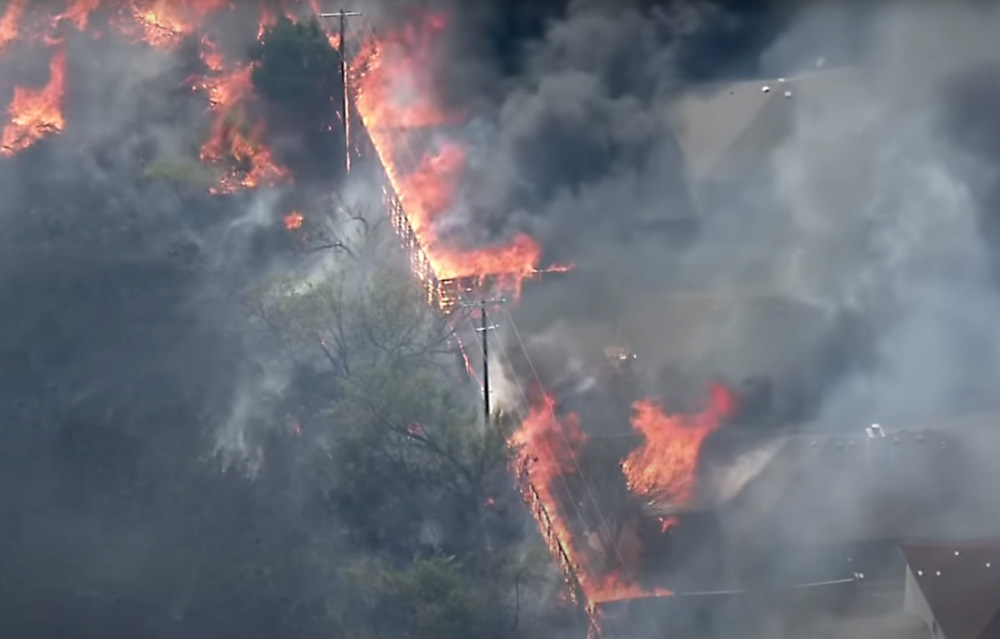
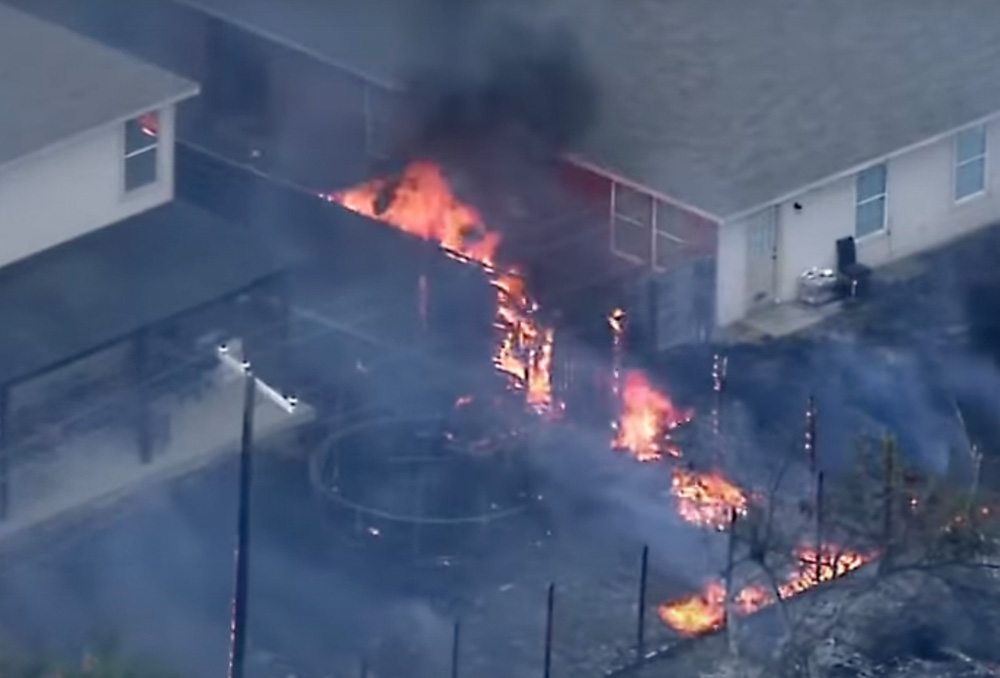
Most structures that burn in a wildfire are not ignited by direct flame impingement, but by burning embers that are lofted and carried downwind ahead of the fire. At Wildfire Today we first covered the role of embers in igniting structures in 2010, a concept brought into the public consciousness by Jack Cohen, a researcher at the Missoula Fire Science Lab. To reduce the chances of a home burning in a wildfire, the most bang for the buck is to concentrate on the Home Ignition Zone. The flammable material near the structure needs to be modified, reduced, or eliminated to the point where multiple burning embers landing in the zone will not propagate the fire and spread to the structure.
More information: Six things that need to be done to protect fire-prone communities
Thanks and a tip of the hat go out to Gerald.

Bob S. asked: “So…if you want a privacy fence, what do you use for the vertical “slats” ?”
I’ve always wondered where to direct a wake-up call regarding the giant gap in the marketplace for METAL fencing that would provide privacy. I’ve seen some corrugated galvanized treatments that look nice (often though with wood framing) but basically, someone needs to invent attractive, affordable metal panels, probably with piercings in interesting patterns that make it nicer than sheet metal and still provides privacy.
The desire for privacy fencing will never go away. Chain link is ugly and putting slats in it doesn’t give people what they want. There is currently no good product out there. Everyone wants manufacturing jobs to come back to the U.S. – this seems like a no-brainer, and mass production should make it affordable.
I’ve considered having our Nevada County (CA) Coalition of Firewise Communities write letters to executives at Home Depot, Lowes, Ace and True Value, asking them to talk with their suppliers about this critical gap in the marketplace. If anybody here wants to write your own letters, go for it.
Bill, thank you for these great fire photos which will get incorporated into our educational work.
Susan Rogers
Nevada Coalition of Firewise Communities, founding Vice Chair (2017), , currently on Steering Committee
Second thoughts on my own idea: realized that sheet metal fencing would get very hot, thus dangerous as backyard fences where children and pets would be running around.
Could still be used as perimeter fencing. But metal will radiate heat back into the air, and wood does not. Hard to find a good solution here.
I have a vague memory of some analysis after one of the other Redding area fires, maybe the 2018 Carr fire, showing similar spread of fire by fences. Does anybody else remember that? Has there been any consideration of building code changes to address this?
What a cool job. Destructive testing must be like being employed as a perpetual teenage boy, except for the 363 page report part.
Someone above mentioned wood piles. During the Nuns/Tubbs fires, firefighters said pretty much every home that had a wood pile within 75 feet of the home structure was a loser.
So…if you want a privacy fence, what do you use for the vertical “slats” ?
HardiePlank?
https://texasfence.com/services/commercial-fences/commercial-hardie-plank-fences/
I’ve seen a lot of fences bring fire right up to houses and burn them to the ground. Privacy fences are the worst but even split rail fences will burn like a wick. Even a low intensity fire without a lot of embers can creep up to a fence and set it off. On the Marshall fire it was all of the worst conditions all at once: houses very close together, networks of both privacy and split rail fences connecting them all, extreme winds, dry greenbelts winding through subdivisions, and large ember casting from burning homes. Even in homes that had generally very well maintained yards there was just enough debris under the fences to ignite them.
In other words, everything burns ?. Just part of living with fire.
As the Scout Manual says: First, tinder. Then kindling and progressively larger-diameter fuel, then logs. Hotter and hotter ambient temperature. Gasses combust too–first, actually, as it’s a matter of scale. An ignition source and the fire triangle.
Glad to see the research about this, as I suspected. I watched live video of the Marshall Fire as it burned, and I could see the column from my house. A lightbulb came on in my head as I watched fire being carried by wooden privacy fences that back up to Boulder County Open Space just west and adjacent to these subdivisions. The fence rows separating properties moved fire in the prevailing winds towards homes, and you could see the ember showers bombarding the houses, and within minutes start seeing smoke coming from the eaves and roofs. That same wind event that triggered the Marshall Fire blew down 3 sections of cedar privacy fence close to a 2 acre grass field just upwind from us, and between my house and next door. Later when I repaired it, I left out a couple of sections.And fortunately there is irrigated lawn on both sides of the fence.